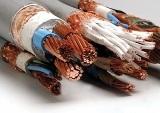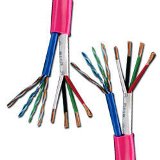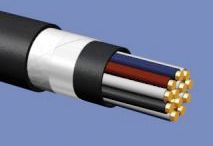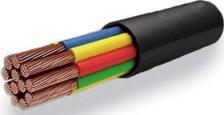Wires and cables in automation systems
 V automation systems use a large number of cables and wires of different purpose and device:
V automation systems use a large number of cables and wires of different purpose and device:
- control cables,
- signaling and blocking cables,
- control cables,
- installation cables and wires,
- wires and cables for electrical installations.
 Control cables are designed for connection to electrical devices, devices in electrical distribution devices with alternating (up to 600 V and frequency up to 100 Hz) or direct voltage up to 1000 V at ambient temperatures from -50 to + 50 degrees. S.
Control cables are designed for connection to electrical devices, devices in electrical distribution devices with alternating (up to 600 V and frequency up to 100 Hz) or direct voltage up to 1000 V at ambient temperatures from -50 to + 50 degrees. S.
Control cables can have a core with a cross-section from 0.75 to 10 mm2, made of one copper or aluminum wire, the number of cores is 4,5,7,10,14,19,27,37.
The conductors can have rubber, PVC or polyethylene insulation. A sheath is placed over the veins, and an armor of two steel strips can be placed over it, and sometimes a protective coating.
The control cables are marked as follows: Х0КХ1Х2Х3Х4 — Х5Х6,
where X0 — core material: A — aluminum, copper has no designation, K — control, X1 — insulating core material: P — rubber, B — polyvinyl chloride, P — polyethylene, Ps — self-extinguishing polyethylene. X2 — shell: B — polyvinyl chloride, VGE — polyvinyl chloride on a common screen made of aluminum or copper foil, N — refractory rubber (neurite), C — lead, X3 — armor: B — two steel strips, Bb — one profiled steel strip , K — round galvanized steel conductors with rubber insulation of the core, PB — also with PVC or PE insulation of the core, X4 — protective armored sheath: G — absent, N — fireproof, Shv — PVC hose, X5 and X6 — number and section of wires, mm2.
Example of designation: КВБбШв — 4 x 2.5
K — control with copper wires, B — insulation of wires — PVC joint, Bb — no sheath, therefore the armor is indicated by one profiled galvanized steel strip, Shv — protective cover made of PVC hose.

Control cable KVBbShv
AKRVGE — 4 x 2.5 — aluminum conductor, control cable, rubber insulation of conductors, polyvinyl chloride jacket, bare (no armor) but has a screen of copper or aluminum foil on top of which the jacket is laid, 4 conductors with a cross section of 2.5 mm2 each.
Insulated wires are twisted into control cables. Each line has a blue or blue count vein, and next to it is a red or pink directional vein.

Control cable KRVGE
Signaling and blocking cables are designed for railway circuits, fire automation, telegraph and other systems at alternating voltage 300 V and DC 700 V, at ambient temperatures from -50 to + 60 degrees. S.
Signaling and blocking cables are produced only with copper wires, wire diameter 1.0 mm. Insulation of cores and sheaths — polyethylene or PVC compound. Can be armored with two steel straps.
The marking is similar to the control cables, only the first letters are «SB» - signal and blocking cables. Insulated wires or pairs are twisted. In a cable with more than 7 cores in each layer, two adjacent cores have a color that distinguishes them from each other and from the other cores.
The number of pairs of wires: 1,3,4,10, 12, 14, 19, 24, 27, 30. Wires — from 2 to 61. Cables can have a screen of aluminum tape or metallized paper and with a longitudinal laying of copper wire with diameter 0.5-0.6 mm, having contact with the shield along the entire length, for grounding the shield.

Signal-blocking cable SBPuE
Control cables intended for control, monitoring and information purposes in installations with voltages from 127 to 1000 V.
Control cables are made only with copper conductors insulated with a core of rubber, polyethylene and polyvinyl chloride or heat-resistant insulation of fluoroplastic or silicon organic rubber. A rubber or PVC sheath and in some cases a braid of galvanized, stainless steel or tinned copper wires is applied to the twisted insulated wires. The cross section of the wires is from 0.2 to 2.5 mm2. The number of veins is from 2 to 68.
Cable designation: the first letter is K, the second letter is Y, which means the control cable. After these letters, the designation of the insulation of the veins is placed: P — rubber, P — polyethylene, B — polyvinyl chloride, DF — fluoroplast.The flexible cable has the letter G in the designation, which is placed after the letters KU or after the designation of the insulation of the wires, for example, KRG.
The last letters in the designation mean either the sheath or the characteristics of the cable: C — power, M — modernized, EM — modernized shielded, TV — for electronic devices of strain gauges, RT — heat-resistant rubber sheath.
The most widely used control cables are KRShU, KRShM, KRShUE, KRShUEM — for flexible installation of control systems in electrical installations operating outdoors. The number of cores is 4, 7, 10, 12, 16, 19, 24, 27 and 37, cross-section — 1 mm2, insulation — rubber.

Control cable KRShU
KUPR — 500, with polyethylene insulation of wires with a cross section of 1, 1.5, 2.5 mm2, number of wires from 7 to 37, rubber sheath on top. Designed to work in the field.
KUGVV — flexible multi-core with polyvinyl chloride insulation of wires, in PVC sheath, cross-section of wires — 0.35 mm2, number of wires from 7 to 61. Intended for fixed installation of control and control circuits.
Mounting cables and wires are used for internal and inter-instrumental mounting of devices and apparatus. These wires and cables are used with PVC, PE, PET, rubber and fiber insulation, round and tape.
Cables have the first letter K or MK in the designation, MG wires — flexible, stranded, MSh — stranded hose (cable), Sh — cable, P — wire and other letters: R — radio installation, LL — PTFE insulation (with fluoroplastic insulation) . The number of cores is from 1 to 61, the cross section is from 0.12 to 6.0 mm2.
The most typical brands: KMV cable — tinned copper wire core, cross-section 0.5 and 0.75 mm2 and PVC joint, PVC sheath, core — 2,3,5,7.

KMV cable
Copper wires and cables use:
- in the measuring circuits of resistance thermometers,
- in electrical wiring of automation systems for explosive and fire installations,
- in installations subject to vibrations,
- in circuits for measurement, control, power supply, signaling, etc., with a voltage of up to 60 V with a wire cross-section of wires and cables up to 0.75 mm2.
The minimum permissible cross-sections of wires of wires and cables of electrical wiring of automation systems must be:
a) in circuits with voltage up to 60 V — at least 0.2 mm2 (diameter 0.5 mm) for copper wires,
b) in circuits with voltage over 60 V — at least 1 mm2 for copper wires, 2.5 mm2 for aluminum wires.
